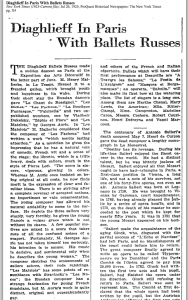Researching a topic that has been done and redone has advantages and disadvantages.
The amount of scholarship on the Ballet Russes can be a bit overwhelming, but the availability of information is convenient. I’m going to focus on a positive part of my research.
As a prestigious troupe lead by the equally prestigious Serge Diaghilev, there are a few areas of research that have proven to be treasure troves of interesting, information, opinions, portrayals etc.

http://search.proquest.com/cv_705429/docview/103628178/pageviewPDF?accountid=351
The New York Times (among other newspapers) has reviews, advertisements, and even a memorial of sorts dedicated to Diaghilev.
Some articles simply list names of performers and dates. While this seems uninteresting, the widespread popularity of the Ballet Russes can be tracked by how many different places documented their performances.
Certain more extensive articles on Diaghilev prove useful as well. His influence on the troupe is quite apparent and many article writers have strong opinions about his artistic ideas and direction.
One of my most interesting sources thus far is an article written by the music critic Henry Prunieres in 1929 that is dedicated to the late Diaghilev. As a French musicologist who was present for the development and fame of the Ballet Russes, his perspective is extremely valuable.
Of course it is important to recognize that all of these primary sources provide interesting but biased opinions rather than facts. They help create a cultural and ideological landscape surrounding music, and more specifically modern ballet in Paris in the 1920s.
As long as these sources are properly balanced with more objective scholarship (New Grove, various encyclopedias, etc) they provide excellent material for a creative research paper.
You must be logged in to post a comment.